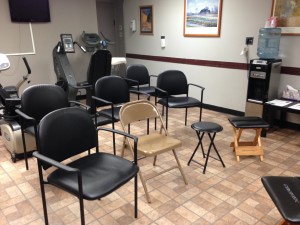

Despite yesterday’s inclement weather, which we did not permit to snow on our parade, Revitalize Physical Therapy accomplished a huge milestone- we hosted our first ever Wellness Workshop! The event was graciously co-hosted by Elite Care Rehab, and it was organized in collaboration with Aubrey Kupstas, a fellow Washington Heights resident who is a certified gyrotonics and gyrokineses instructor. In addition, Dominique Rose-Hadar, an excellent event planner and dear friend, helped plan the intricate details of the event and facilitated the transition of our vision from conception to reality.
The event was attended by community members, current and former clients of both Elite Care Rehab and Revitalize Physical Therapy, and even by one former client’s five year old granddaughter who participated beautifully in the program! The program itself consisted of a brief introduction to pelvic floor physical therapy and gyrotonics. Aubrey and I discussed the delicate balance that individuals should strive to achieve within one’s own body, namely the ability to perform stabilizing and strengthening exercises while still maintaining mobility and lengthening. I proceeded to explain how this concept connects to the pelvic floor, and I taught the group how to properly perform diaphragmatic breathing. In addition, I explained how diaphragmatic breathing benefits the pelvic floor, reduces stress, and promotes overall relaxation.
Aubrey explained how gyrotonics compares to pilates, yoga, and ballet, and she explained how gyrotonics allows for strengthening through movement. She then led the group in a mini gyrotonics session, which was followed by a brief Question and Answer segment. We concluded the event with some delicious and healthy snacks (…okay, and some Twix as well. Everything in moderation, right?) Fortunately, we received excellent feedback about the event, and participants reported that they enjoyed meeting the other workshop participants and that it was “well done and informative.” The event served as a wonderful opportunity to connect the Elite Care Rehab and Revitalize Physical Therapy communities with each other and to introduce both of them to the amazing world of gyrotonics!
Upset that you missed out on our inaugural event? Don’t worry- we hope to plan additional health related events. So stay tuned for more information about similar future opportunities, and please comment or email me if you have any suggestions about topics that you want us to explore together with you! We look forward to sharing more information, exercises, and chocolates with you.


